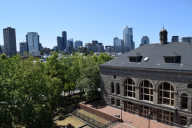You have /5 articles left.
Sign up for a free account or log in.
Many administrators of land-grant universities at some point pose milking a cow. It shows a connection to the agricultural research roots of the institutions.
Dan Bernardo, provost of Washington State University, has taken that sort of commitment to agriculture research to a new level. To raise money for a research center on honeybees, he arranged to have his face and upper body covered with bees.
As the video below shows, Bernardo has a mustache but is otherwise clean shaven, so after the bees settled on his upper body (he was wearing a sweatshirt), the also landed directly on his face. Via email, he said that he wore a necklace with a queen bee and that attracted the other bees quickly. He also wore a small amount of insect repellent on his nose, ears and mustache so the bees wouldn't congregate there.
Numerous bee experts were present, so Bernardo said he never felt in any danger.
“Initially, there’s this scratchiness, sort of moving sensation. It’s very noisy, maybe a little nerve-racking," he said. "But I wasn’t nervous. We had paramedics and every bee expert within 1,000 miles here, so I figured I was in good hands."
He said the bees were on him for about 15 minutes. To encourage them to leave after that time, as he was instructed, he jumped up and down and most of them flew off. A few had to be brushed off.
As a former agriculture college dean, Bernardo said that he has long respected the bee scholars at the university and the support for Washington State from the honeybee industry. He said it was on an informal visit he made to the entomology department that professors came up with the idea. "I am a fairly adventurous person and will do just about anything for WSU (also my alma mater), so I said yes on the spot," he said.
Bernardo, along with a local beekeeper, agreed to match all donations for the new center inspired by his action, up to $25,000.
The research center will cost $16 million, and Washington State is trying to raise all funds privately. Details on the university's bee research efforts may be found here.
Time-lapse video shows how the bees were placed on the provost.







